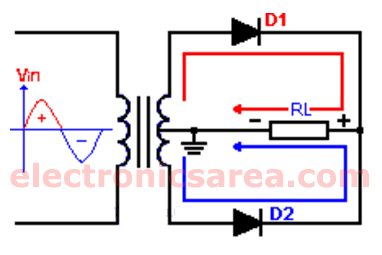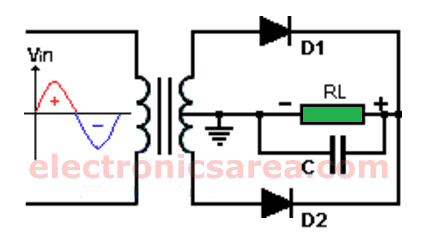Full wave rectifier using center tapped transformer
The unregulated power supply
This full wave rectifier requires a center tapped transformer. This additional end on the secondary winding of the transformer divides the voltage in this winding into two equal voltages. This additional end is grounded. During the positive half-cycle of the input voltage (see the red color of the Vin waveform):
– D1 diode is direct polarized and the current flows through the diode.
– The current passes through the upper part of the transformer secondary, through the D1 diode, through RL and ends into ground.
– D2 diode does conduct as it is inversely polarized.
During the negative half-cycle (see the blue color of the Vin waveform):
– D2 diode is direct polarized and the current flows through the diode.
– The current passes through the lower part of the transformer secondary, through the D2 diode, through RL and ends into ground.
– D1 diode does not conduct as it is inversely polarized.
Both semicycles of the input voltage are summed and and the output voltage is as in the following diagram:
The ripple voltage
If a capacitor is placed parallel to RL, the output voltage will be seen as in the lower diagram (black line).
The voltage variation (Δv) at the capacitor ends, is due to the capacitor discharge through the load resistor and it is called: Ripple voltage.
The amplitude of this ripple voltaje depends on the load resistor and capacitor values.
If this diagram is compared with the corresponding 1/2 wave rectification diagram, it can be seen that this circuit has a higher ripple frequency (double) but less amplitude. See ΔV in the Half-wave rectifier (1/2 wave rectifier).
On each half cycle, the transformer delivers current (through the diodes D1 and D2) to the capacitor C and to the load resistor RL. This happens while waves increase to their maximum value (peak value), but when this value goes down, capacitor is discharged through RL (capacitor is delivering current to the load).
A large capacitor value means less ripple voltaje, but even if this condition is met, the ripple voltaje could be large if the load resistor is very small (the load current is large).
Note: It should be noted that the maximum voltage we can obtain from this circuit depend on the voltage between one of the ends of the transformer secondary and its central tap.








